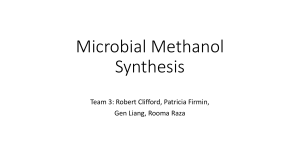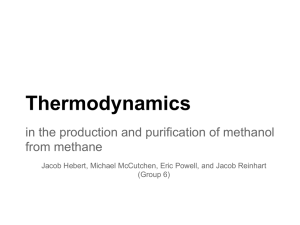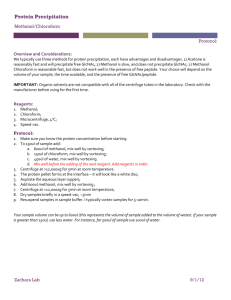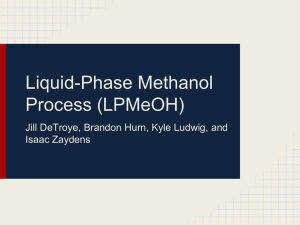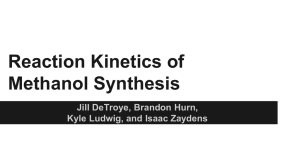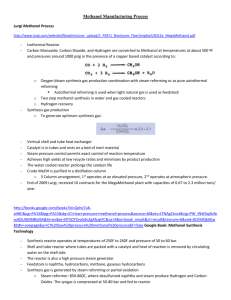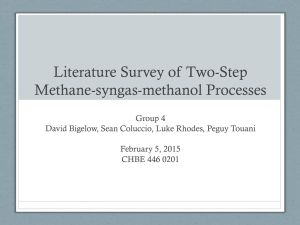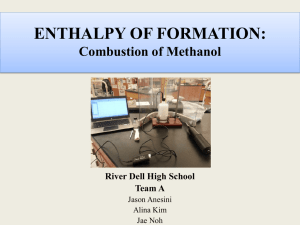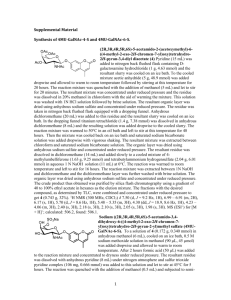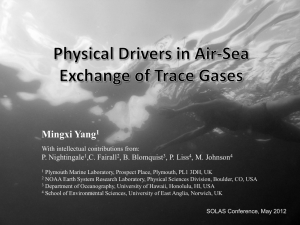1-step direct oxidative synthesis of methanol from methane
advertisement
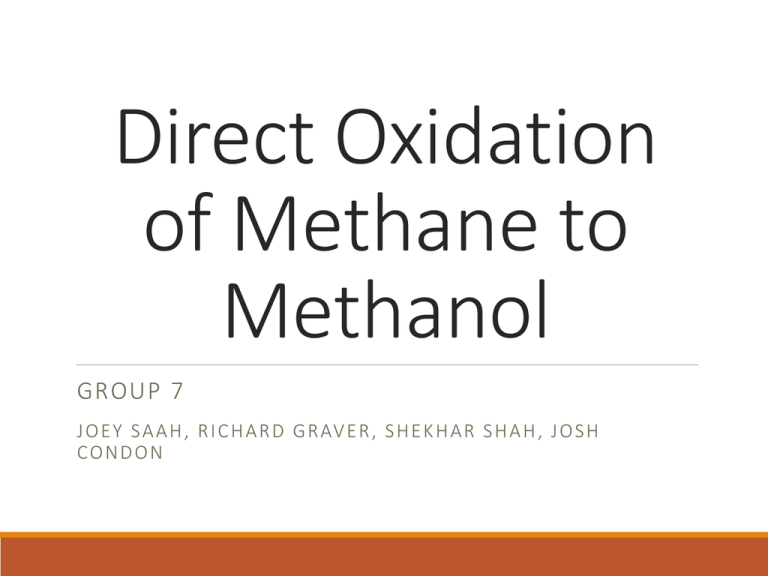
Direct Oxidation of Methane to Methanol GROUP 7 J O E Y S A A H , R I C H A R D G R AV E R , S H E K H A R S H A H , J O S H CO N D O N Methanol Applications ◦ Solvent ◦ Gasoline additive ◦ Feedstock for many chemical processes 21 million tons produced per year Primary component of natural gas ◦ Currently an abundant fuel source ◦ Difficult and uneconomical to transport Simple and cost effective on-site process required wikimedia.org Standard Methanol Synthesis Conversion of natural gas into syngas ◦ Steam reforming reactor with catalyst ◦ Creates carbon monoxide and hydrogen from methane Syngas to Methanol ◦ H2 and CO react in 2:1 ratio to form methanol ◦ Catalyst selectively forms methanol Haldor Topsoe One-Step Methanol Process Advantages ◦ ◦ ◦ ◦ Steam in steam reformer is expensive to produce Less capital costs required to build one-step plant May be created near more remote methanol sources Remote methanol sources more profitable, attractive Challenges ◦ Past one-step reactions showed low yield or selectivity with homogeneous and heterogeneous catalysts ◦ Other methods did not produce methanol levels required for commercialization ◦ Liquid phase or Supercritical reactor methods History of Methanol 1661 – Methanol discovered by Robert Boyle 1834 – The chemical structure and identity of methanol was identified by Dumas and Peligrot Destructive distillation of wood was the first method to produce methanol ◦ Pyrolysis in a distillation apparatus History of Industrial Methanol Production First synthetic methanol production route discovered in 1905 BASF commercialized the process in 1934 ◦ Zinc-Chromium Oxide Catalyst ◦ 300 °C and 200 atm ◦ This process was used until 1966 when a lower pressure, higher efficiency method was discovered History of Industrial Methanol Production cont. Imperial Chemical Industries, Ltd. discovered a new process in 1966 ◦ Copper-Zinc Oxide catalyst ◦ 250-300 °C ◦ 50-100 atm Poisoning of catalyst was a problem for this method Lifetime of catalyst is about 4 years ◦ Only if there is good control of temperature and feedstock purity Thermodynamic Analysis ΔG reaction (KJ/mol) Reaction 298 650 700 750 800 1000 Direct CH4+1/2O2 CH3OH -111 -93 -91 -88 -86 -76 SR CH4 + 1/2O2 CO + 2H2 -86 -152 -162 -172 -182 -222 SR CH4 + H2O CO + 3H2 142 60 48 36 23 -27 Optimal Conditions Traditional steam reforming requires 1000 K or higher Direct oxidation (direct synthesis) favorable at lower temperatures thermodynamically Theoretically, 33% equilibrium conversion at 298 K for direct synthesis Maximum of 5 % equilibrium conversion in direct synthesis actually obtained due to high activation energy Thermodynamic Requirements Direct synthesis would be economically feasible (compared to traditional method) if 5.5% conversion and 80% selectivity to methanol is obtained in the reaction Low conversion requirement is indicative of the high cost of current methanol production CO2 and CO are thermodynamically the most favorable products of direct oxidation (selectivity to methanol is a challenge) Why do we need a catalyst? Methane is a more stable molecule than methanol ◦ Reaction equilibrium favors methane at operating conditions ◦ Low conversion ◦ Large activation energy Complete oxidation to carbon monoxide and carbon dioxide is thermodynamically favored ◦ Low selectivity for the partially oxidized product Harsh operating conditions ◦ Requires 440 kJ/mol to break the first C—H bond ◦ 50-100 bar and 500-550 K ◦ Energy intensive step would be eliminated Important Catalytic Parameters 1.Temperature 2.Pressure 3.Oxygen concentration in the feed gas 4.Gas flow rate 5.Additives These parameters are critical to optimizing the conversion of methane and selectivity toward the methanol product. Heterogeneous Catalytic Partial Oxidation Direct conversion of methane and oxygen to methanol ◦ Conversion of methane and selectivity to desired product are limiting factors ◦ Activation energy for the reaction is extremely large and limits the conversion of methane to products CH4 + ½ O2 CH3OH Direct Oxidation Reaction Involves the abstraction of a hydrogen from methane to create a methyl radical followed by subsequent reaction to form methoxide ions ◦ Solid catalysts containing metal oxide catalysts have been effective at removing hydrogen References Khirsariya, P., Mewada, R. “Single Step Oxidation of Methane to Methanol – Towards Better Understanding”. Procedia Engineering 51 409-415. 2013.

